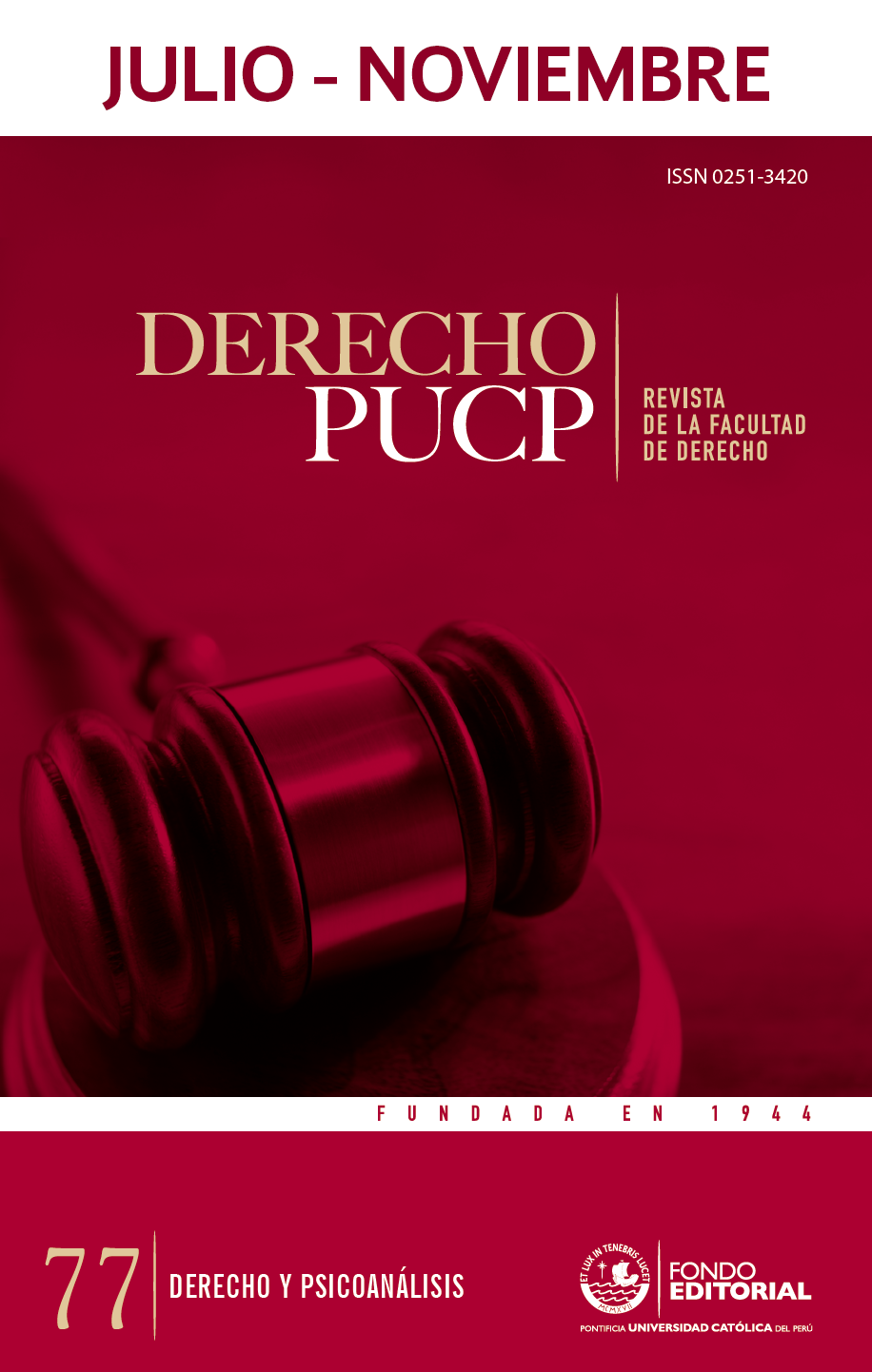La visión dominante de la ética profesional del abogado como obstáculo a la construcción de un trauma cultural y como causa de un trauma individual
DOI:
https://doi.org/10.18800/derechopucp.201602.009Palabras clave:
derecho, psicoanálisis, trauma psicológico, trauma cultural, ética profesional, abogadosResumen
El derecho y el psicoanálisis son disciplinas que tienen propósitos diferentes y se formulan preguntas distintas. No obstante, son varios los esfuerzos que se han hecho y las posibilidades que existen para que ambas disciplinas puedan interactuar. Una de las formas a través de la que se ha propuesto una aproximación interdisciplinar es la idea según la cual los procedimientos judiciales pueden convertirse en escenarios para la socialización de un trauma de naturaleza individual y su consecuente tránsito hacía un trauma cultural de tipo colectivo. El presente artículo tiene como propósito advertir los riesgos de esta estrategia y demostrar, a través de un ejemplo puntual, cómo los procesos judiciales pueden fallar en este propósito y constituirse más bien en un escenario de revictimización. En este proceso de revictimización juegan un papel determinante los abogados, la concepción estándar de la ética profesional del abogado y la forma en la que esta enmarca sus deberes profesionales.Descargas
Citas
Alexander, Jeffrey C. (2012). Trauma: A Social Theory. Cambridge-Malden, MA: Polity.
Anónimo (s/f). Here is the Powerful Letter the Standford Victim Read Aloud to Her Attacker. Disponible en: https://www.buzzfeed.com/katiejmbaker/heres-the-powerful-letter-the-stanford-victim-read-to-her-ra?utm_term=.lvgG2J6g2v#.afnmwlRrwD
Bienenfeld, Franz Rudolf (1965). Prolegomena to a Psychoanalysis of Law and Justice. Part II: Analysis. California Law Review, 53(5), 1254-1336. https://doi.org/10.2307/3478954
Caruth, Cathy (1996). Unclaimed experience: Trauma, Narrative, and History. Baltimore: Johns Hopkins University Press.
Caudill, David S. (1990). Freud and Critical Legal Studies: Contours of a Radical Socio-Legal Psychoanalysis. Indiana Law Journal, 66(3), 651-697.
Cover, Robert M. (1986). Violence and the Word. Yale Law Journal, 95(8), 1601-1629. http://doi.org/10.2307/796468.
Erikson, Kai T. (1976). Everything in its Path: Destruction of Community in the Buffalo Creek Flood. Nueva York: Simon and Schuster.
Felman, Shoshana (2002). The Juridical Unconscious: Trials and Traumas in the Twentieth Century. Cambridge: Harvard University Press.
Freud, Sigmund (1960). Moisés y la religión monoteísta. Buenos Aires: Losada, 1960.
Freud, Sigmund (1962). The Aetiology of Hysteria. En The Standard Edition of the Complete Psychological Works of Sigmund Freud. Volume III (1893-1899): Early Psycho-Analytic Publications (pp. 189-224). Londres: The Hogarth Press-Institute of Psycho-Analysis.
Freud, Sigmund (1896). Sexuality and the Psychology of Love. Nueva York: Collier Books.Freud, Sigmund (1967). Totem y tabú. Madrid: Alianza Editorial.Freud, Sigmund (1899). La interpretación de los sueños. Madrid: Alianza Editorial.
Freud, Sigmund (1992a). El yo y el ello. En Obras completas, 19 (1923-25). El yo y el ello y otras obras (pp. 1-66). Buenos Aires: Amorrortu. Freud, Sigmund (1992b). El problema económico del masoquismo. En Obras completas, 19 (1923-25). El yo y el ello y otras obras (pp. 161-176). Buenos Aires: Amorrortu.
Freud, Sigmund (1999). El malestar en la cultura. Madrid: Biblioteca Nueva.
Freud, Sigmund (2000). Psicoanálisis del arte. Madrid: Alianza Editorial.
Freud, Sigmund (2011). El Moisés de Miguel Ángel. Madrid: Casimiro Libros.
Galanter, Marc (1974). Why the «Haves» Come Out Ahead: Speculations on the Limits of Legal Change. Law and Society Review, 9(1), 95-160. https://doi.org/10.2307/3053023
Gallo, Héctor (2010). Feminidades: sacrificio y negociación en el tiempo de los derechos. Medellín: Universidad de Antioquia.
Goldstein, Joseph (1968). Psychoanalysis and Jurisprudence. The Yale Law Journal, 77(6), 1053-1077. http://doi.org/10.2307/794884
Goodrich, Peter (1994). Translating Legendre or, the Poetical Sermon of a Contemporary Jurist. Cardozo Law Review, 16(3-4), 963-977.
Goodrich, Peter (1995). Oedipus Lex. Psychoanalysis, History, Law. Berkeley: University of California Press.
Hutchinson, Allan C. (1998). Legal Ethics for a Fragmented Society: Between Professional and Personal. International Journal of the Legal Profession, 5(2/3), 175-192. http://doi.org/10.1080/09695958.1998.9960447
Kennedy, Duncan (1997). A Critique of Adjudication: fin de siècle. Cambridge: Harvard University Press.
Koren, Marina (2016). Telling the Story of the Stanford Rape Case. The Atlantic.Disponible en: http://www.theatlantic.com/news/archive/2016/06/stanford-sexual-assault-letters/485837/.
Legendre, Pierre (1982). El discurso jurídico: perspectiva psicoanalítica y otros abordajes epistemológicos. Buenos Aires: Hachette.
Legendre, Pierre (2008). La fábrica del hombre occidental; seguido de El hombre homicida. Madrid: Amorrortu.
Luban, David (1988). Lawyers and Justice: an Ethical Study. Princeton, NJ: Princeton University Press.
Noonan, John T. (1976). Persons and Masks of the Law: Cardozo, Holmes, Jefferson, and Wythe as Makers of the Masks. Nueva York: Farrar, Straus and Giroux.
Pepper, Stephen L. (1986). The Lawyer’s Amoral Ethical Role: A Defense, a Problem, and Some Possibilities. American Bar Foundation Research Journal, 1, 613–635. https://doi.org/10.1086/492163
Popper, Karl R. (1959). The Logic of Scientific Discovery. Londres: Hutchinson & Co.
Randazzo, Sara (2016). Antidiscrimination Rule for Lawyers Faces Backlash. The Wall Street Journal. 5 de mayo. Disponible en: http://blogs.wsj.com/law/2016/05/05/antidiscrimination-rule-for-lawyers-faces-backlash/.
Sarat, Austin (2014). Introduction: Pain and Suffering as Facts of Legal Life. En Austin Sarat (ed.), Knowing the Suffering of Others: Legal Perspectives on Pain and its Meanings (pp. 1-13). Tuscaloosa: University of Alabama Press.
Sarat, Austin (ed.)(2014). Knowing the Suffering of Others: Legal Perspectives on Pain and Its Meanings. Tuscaloosa: University of Alabama Press. http://public.eblib.com/choice/publicfullrecord.aspx?p=1727535
Simon, William H. (1998). The Practice of Justice. A Theory of Lawyers’ Ethics. Cambridge: Harvard University Press.
Tal, Kalí (1996). Worlds of Hurt: Reading the Literatures of Trauma. Cambridge-Nueva York: Cambridge University Press.
Wendel, W. Bradley (2010). Lawyers and Fidelity to Law. Princeton, NJ: Princeton University Press. https://doi.org/10.1515/9781400836581
Wilkins, David B. (1990). Legal Realism for Lawyers. Harvard Law Review, 104(2), 469–523. https://doi.org/10.2307/1341584
Descargas
Publicado
Cómo citar
Número
Sección
Licencia
Derechos de autor 2016 Derecho PUCP

Esta obra está bajo una licencia internacional Creative Commons Atribución 4.0.




